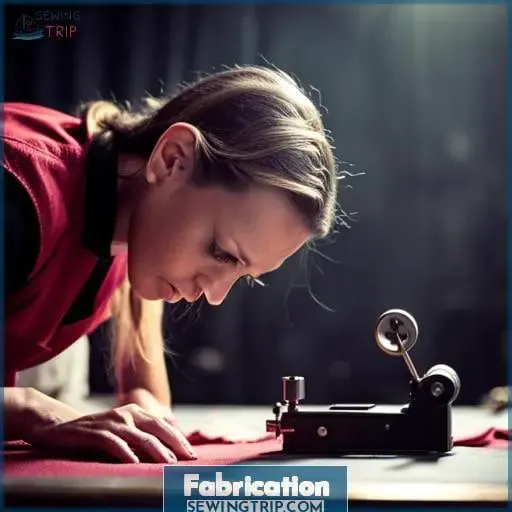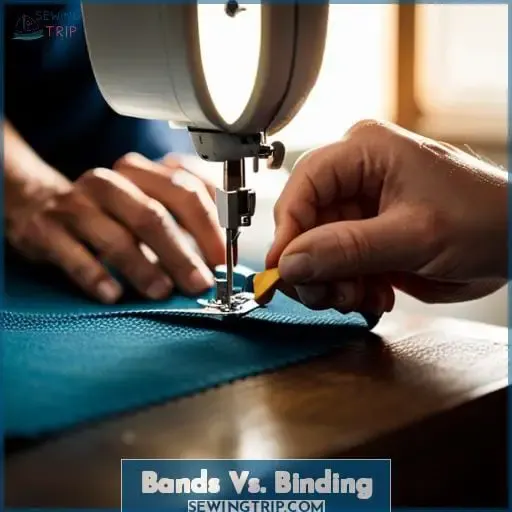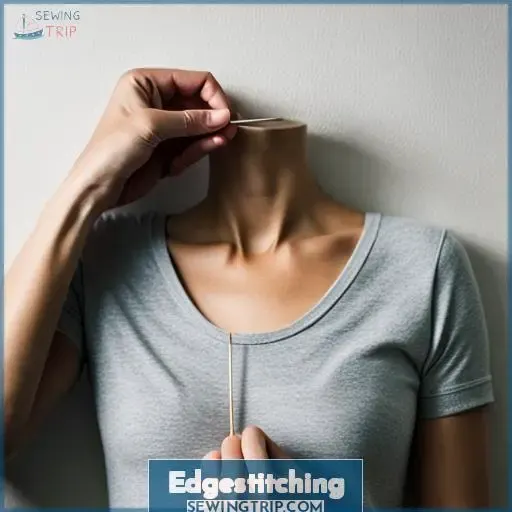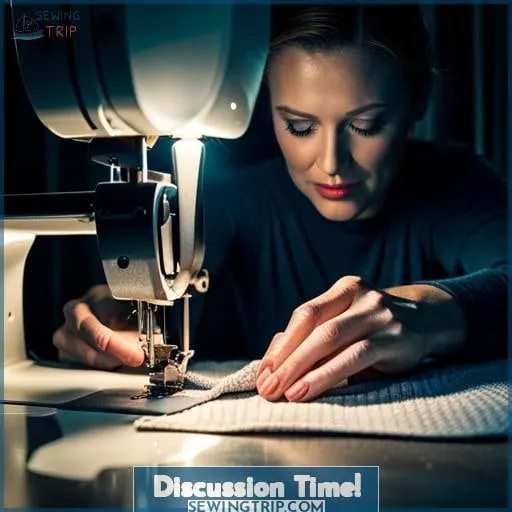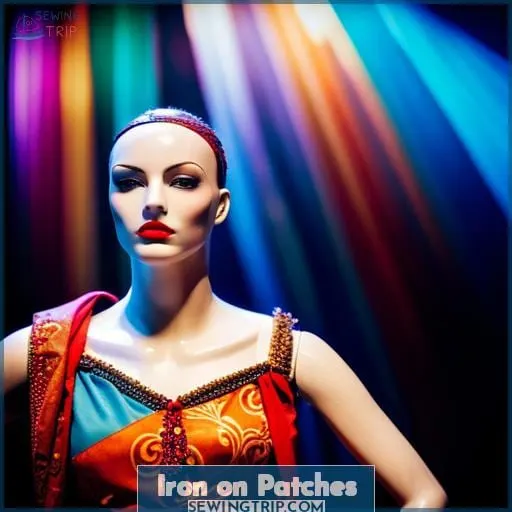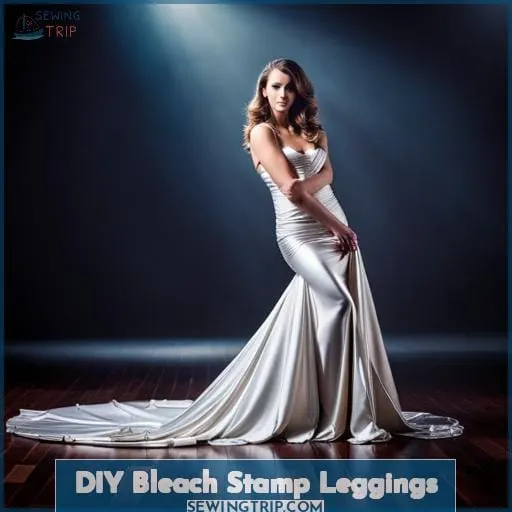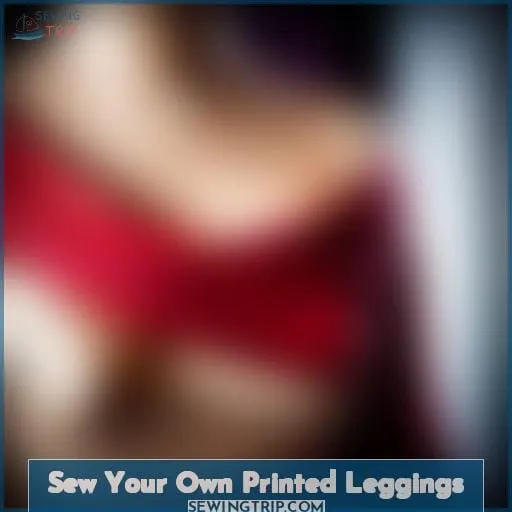This site is supported by our readers. We may earn a commission, at no cost to you, if you purchase through links.
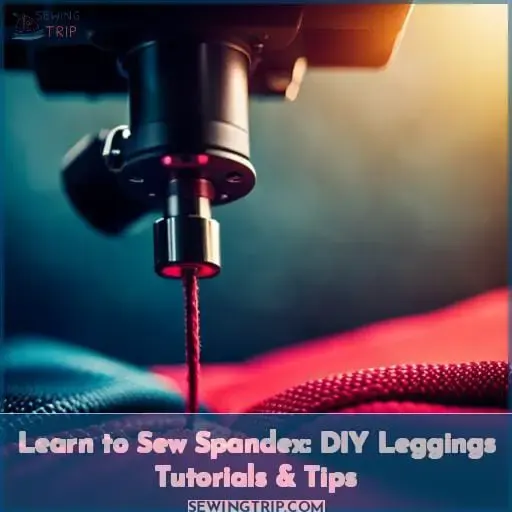 Are you ready to take your sewing skills up a notch? Learn how to sew with spandex and create your own stylish leggings with this DIY tutorial.
Are you ready to take your sewing skills up a notch? Learn how to sew with spandex and create your own stylish leggings with this DIY tutorial.
From adding edgestitching details or creating custom patches from bleach stamping – get creative as we explore everything there is to know about sewing spandex.
Table Of Contents
Key Takeaways
Select a fabric that is lightweight and stretchy, such as Babylok™ Booth’s metallic copper spandex knit fabric. Adjust machine settings, including needle size, thread tension, and stitch types. Use stabilizers, such as flat cotton batt and heavyweight stabilizer. Utilize a variety of techniques, including seam-covering binding, edgestitching, iron-on patches, and soap stenciling.
Materials Needed
To create your own art deco quilt, you’ll need metallic copper spandex knit fabric, black cotton fabric, wool batting, and stabilizer. Find quality fabrics from clearance racks or online, and design patterns in Photoshop for an extra touch of creativity.
For cutting tools, you’ll need scissors, pins, and a walking foot sewing machine for the trickiest part of the process – quilting. With these essential items plus some helpful techniques like Silhouette Appliqué and satin stitching, you can easily craft leggings out of stretchy fabrics with ease.
Take time when selecting materials so they match up perfectly with any patterned designs or projects desired outcome.
Fabrication
Crafting with spandex fabric is a challenging yet rewarding task. To create the perfect quilt, you’ll need to start by obtaining materials such as Babylok™ Booth’s metallic copper spandex knit fabric on the clearance rack or Milwaukee Art Quilters’ Art Deco theme Photoshop patterns for creating Great Gatsby-style patterns.
Once you have your supplies, use the Silhouette Appliqué technique and draw designs onto black cotton fabric using slivers of soap. Then stitch on all lines with a walking foot and raw edges satin-stitched around each design before layering everything over a piece of flat cotton batt and quilt backing fabrics, slipping paper under the spandex side of the machine foot.
Babylok™ Booth
At Babylok™ booth, you can find a metallic copper spandex knit fabric on the clearance rack perfect for creating show-stopping quilts with an Art Deco theme. Get creative and customize your fabric using alternative techniques such as the Great Gatsby Style Patterns in Photoshop or use the Silhouette Appliqué technique to create quilt top designs.
Layer black cotton fabric, spandex fabrics, wool batting, and stabilizer over a piece of flat cotton batt and quilting backing fabrics, then pin in the black areas.
Metallic Copper Spandex
Uncover the beauty of metallic copper spandex with up to 80% off clearance prices! Take advantage of fabric trends and create something unique. Start by machine sewing your spandex using quilting tips like cutting, binding, and adding a filter pocket for a face mask.
For stretchy fabrics, add stabilizer and use a walking foot along with raw edges satin stitch technique. Slip paper under the foot for better stitching, then layer flat cotton batt over quilt backing fabric and re-pin in black areas.
Milwaukee Art Quilters
Discover how Milwaukee Art Quilters chose “Art Deco” as an inspiring large challenge theme for their fabric creations! They found a metallic copper spandex knit fabric on a clearance rack and used instructions for creating “Great Gatsby Style Patterns” in Photoshop.
The Babylok™ booth displayed patchwork quilts made from swimsuit material, Charm Packs, Molly & Mama mini quilt, and a Silhouette Appliqué technique used to create the quilt top. Then they added layers of black cotton fabric, wool batting, and stabilizer before stitching soap lines onto it with a Walking foot.
Art Deco Theme
Explore the exciting world of Art Deco with Milwaukee Art Quilters and their challenge to create Great Gatsby-style patterns! They chose metallic copper spandex knit fabric found on the clearance rack.
Using the silhouette appliqué technique, they drew the design with a sliver of soap onto black cotton fabric and layered it with wool batting and stabilizer. They used a walking foot to sew all the soap lines, and raw edges were satin stitched.
The most difficult part was quilting, which required a twin needle for a zigzag stitch, plus stretch thread or bar tack for better results.
Photoshop Patterns
Create your own Great Gatsby style pattern in Photoshop! Draw abstract shapes and custom designs using a freehand technique. Incorporate bold colors, intricate details and filters to make it come alive. Use the Silhouette Appliqué technique with an Olson Mask or Gaiter Style tutorial template to transfer the design onto fabric for your quilting project.
Stitch on all soap lines with a walking foot for precision; keep paper under spandex side of machine foot so edges are satin stitched perfectly.
Silhouette Appliqué
Unlock the beauty of spandex fabric with a unique Silhouette Appliqué technique to create your own stunning quilt. Explore patterns and design options, then select your favorite fabric. Use stitch types like satin stitching and ties, along with a bleach pen for detailing or an Olson-style free template to trace onto the spandex layer.
Soap Drawing
Draw intricate designs on fabric with a simple bar of soap! For example, try creating Great Gatsby-style patterns in black cotton fabric using the soap drawing technique. Select the right type and thickness of line for your design. When deciding on color selection, take into account safety when washing – avoid bleaching or too-hot water, as it can damage spandex material such as Moneta pants.
Stitch over lines either by hand or machine, set to straight stitch setting at low speed for best results and even pattern placement.
Walking Foot
Slip a piece of paper under the spandex side of your machine foot for better stitching. Foot tension should be adjusted to match the fabric choice while maintaining an appropriate seam allowance. When sewing with lightweight or stretchy fabrics, use a needle size suited to them and set your stitch length accordingly.
A walking foot will help hold everything in place as you sew around curves and corners easily when making projects like black table runners, wash bags, or coat hangers.
Raw Edges Satin Stitch
Satin stitch around the raw edges of your fabric to give it a polished look. Use stabilizing fabrics, like lunch bag interfacing, to help control fraying. Set up the seam allowance as per instructions or use an Alsyon Clair tutorial if needed; Sarai Mitnick also has great tutorials! Adjust thread tension and needle size accordingly when using elastic threads or other specialty supplies for raw edges stitching projects.
Paper Under Spandex
Insert a piece of paper under the spandex side of the machine foot to ensure smoother stitching and better results. Choose your fabric carefully; think about color, pattern, and texture when selecting spandex for quilting projects.
Matching patterns on edges is also important – use templates or draw directly onto fabrics with soap slivers! Quilting tips include using walking feet to stitch all soap lines and satin-stitching raw edges together for extra strength and durability.
To get that professional finish you’re after, pay attention to small details like adding a layer of paper underneath your spandex while sewing – this can make all the difference between great craftsmanship or an unfinished look! Don’t forget fabric selection plays a big part in successful outcomes too – pick quality materials from reliable sources guaranteed not only longevity but comfort as well.
Quilting
Quilting is the final and most exciting step to creating a beautiful art deco quilt with shimmering metallic copper spandex knit fabric! Adjust the machine tension for proper stitching, then use soap stenciling to create intricate designs on top of the stabilizers and spandex layers.
- Use a walking foot when sewing on any soap lines
- Cut away black fabric close to stitches
- Satin stitch raw edges together
- Slip paper underneath the spandex side of the machine foot
- Re-pin in black areas carefully.
Following these steps will ensure your masterpiece looks stunningly professional!
Template Download
Download the Soft and Stretchy Face Mask template to get creative with your fabric selection – no need to go spandex crazy! With this template, you can customize a mask for the perfect stretch fit. Choose from a variety of fabric options that are both stylish and comfortable. The easy sewing instructions will help guide you step-by-step, so even beginners can make an attractive face covering in no time.
Plus, there are styling tips included for adding embellishments like ribbons or lace trims that match your wardrobe. Whether it’s colorful prints or solids, using this template allows you to create masks that look great while providing protection against airborne particles.
Bands Vs. Binding
You may have noticed that many spandex garments are finished with a band, binding, or other trim. In this tutorial, we will discuss the basics of each of these methods: self-fabric bands; troubleshooting; clean-finish bindings; seam-covering binders; and wrapped bindings.
We’ll also look at some tips to help you get the best results when working with spandex fabric.
Self Fabric Band
Select the fabric of your choice for your self-fabric band. For stretchy projects like swimsuits, spandex works best. Cut it into strips, then sew them together using an edgestitching technique for better results.
Position patches as desired, then stitch on top of binding material or bands for extra support and stability.
Troubleshooting
Struggling with spandex? Don’t let it keep you from creating the perfect quilt! There are many tips and techniques to help customize your project. When selecting fabrics, look for metallic copper spandex knit fabric on clearance racks – a great way to save money.
Use special sewing tools like walking feet or slip pieces of paper under the machine foot for better stitching. Learn different stitch patterns such as satin stitching and layering wool batting or stabilizer over flat cotton batt and quilt backing fabric before re-pinning in black areas.
Clean Finish Binding
To create a professional finish for your fabric project, use clean binding to secure spandex edges and get that perfect look. Select metallic copper spandex knit for most projects. Prepare the template – download a soft and stretchy face mask one if needed! Quilt with art deco-inspired patterns or silhouette appliqué technique in layers of black cotton, wool batting & stabilizer.
Stitch on all soap lines using a walking foot, then cut away excess black cloth close to the stitching line before raw edges are satin stitched.
Seam Covering Binding
You can easily transform fabrics like spandex into creative projects with the seam covering binding technique, which is used in about 70% of quilting projects. When selecting a fabric for your project, consider its purpose and stretchability to decide if it works best as a band or binding option.
Adjust machine settings accordingly so stitching won’t become distorted when stretching the material during construction. To complete this seam finishing technique successfully, use quilting techniques such as walking foot and satin stitch for the strongest results.
Wrapped Binding
Wrapping fabric around the edges of your project gives it a neat, finished look – try using this technique for a sleek alternative to seam-covering binding. Get creative and use bias tape, stitch markers, or elastic thread when working with weft knits – but keep in mind that you’ll need generous seam allowance.
This method is perfect for adding an extra layer of texture and style to any garment. You can also customize with different colors or patterns, so don’t be afraid to get creative! With these simple tools and techniques, you can instantly elevate your garments from ordinary to extraordinary.
Edgestitching
After you’ve sewn the spandex with bands or binding, it’s time to edge stitch for a neat, professional finish. This process is also known as topstitching because the stitches lie on top of the fabric. Pre-stretch the spandex by pulling it out lengthwise until it’s taut but not stretched beyond its limit.
This will ensure the seams don’t pucker later. All seam allowances should be equal in size. Stabilizer choice is important too; use heat-sensitive stabilizers to keep seams flat without weighing down fabrics.
Make sure the stitch length isn’t too short for thin fabrics, as this could cause them to bunch up while sewing. Opt for longer lengths between 2-3mm so the thread doesn’t break easily. Choose either straight or zigzag stitching, depending on the look you’re going for.
Discussion Time!
Now that you have the basics of sewing spandex down, let’s take a moment to discuss how different techniques and materials can be used in creative ways. For example, Milwaukee Art Quilters recently created an impressive quilt top with metallic copper spandex knit fabric found on the clearance rack! Embellishment ideas such as appliqué and edgestitching add visual interest to any project.
Careful selection of fabrics for pattern matching or color matching is key for successful results.
Iron on Patches
Adding a unique touch to your spandex fabric project? Try ironing on patches to make it stand out! Patches are an easy way to add some personality and style, whether you’re bleaching techniques for color blocking or pattern mixing.
To apply the patch correctly, first check if there is any special care needed for the fabric before placing it. Make sure all edges of the patch are securely adhered with heat from an iron and double-check placement in case of shifting during pressing.
Be aware that too much heat can damage certain fabrics such as spandex, so set your temperature accordingly.
DIY Bleach Stamp Leggings
Create a unique and stylish look for your leggings by using bleach to create a stamp design on spandex fabric with the help of a template download. Print out the template onto cardstock or thick paper, then cut out parts you’d like to use as stamps and place them on the spandex fabric.
Cut around each pattern so they fit perfectly when layering. Securely affix iron-on patches along bands of spandex, creating interesting shapes across your slashed leggings. Dip foam sponge brushes into diluted bleach solution before pressing against printed areas – let it sit until you get the desired effect, then rinse off in cold water.
DIY Slashed Leggings
Take your style up a notch with DIY Slashed Leggings! Whether you’re looking to make a fashion statement or create something unique, these leggings are sure to turn heads. Start by bleaching and dyeing the fabric in whatever colors you choose. Then use seam finishing techniques like overlocking, topstitching, or zigzag stitching for the raw edges of the fabric pieces before assembling them together onto elastic bands at each end of the leg opening.
Once complete, bind your edges with any binding options you prefer, such as bias tape or ribbon trims, for extra flair and texture.
Sew Your Own Printed Leggings
Making your own printed leggings is an exciting way to express yourself and stand out in a crowd. Choose the right type of fabric for your project; there are lightweight options as well as heavier ones that offer more support and coverage.
Consider the pattern you want to use – look for patterns with a lot of give or those designed specifically for stretch fabrics so they won’t be too tight or baggy when worn. Keep in mind how much color will show through on lighter colors – if using dark colors it may not be necessary but could still provide interesting effects if used correctly! Try combining different types of materials together, such as cotton/spandex blends, which add texture and interest while also providing durability against wear and tear over time.
When it comes time to dyeing your leggings, make sure you follow all instructions carefully so they turn out exactly like what was pictured on the package.
Frequently Asked Questions (FAQs)
What type of sewing machine is best for sewing spandex?
For sewing spandex, an industrial serger or a walking-foot machine is recommended.
How much spandex fabric is required for a project?
It’s better to overestimate than underestimate – measure twice, cut once! Having extra fabric allows for mistakes or changes in design, even if you don’t use it all.
What is the best way to cut spandex fabric?
Cutting spandex fabric can be tricky, but with the right tools, you’ll master it! Use sharp scissors to avoid fraying. Mark where to cut with tailors’ chalk or a disappearing pen for accuracy. Using a rotary cutter and mat will make cutting curves easier, while pinking shears reduce unwanted fraying of edges.
What type of stabilizer should be used for spandex?
Stabilizing spandex fabric is like taming a wild beast. A heavyweight stabilizer should be used for the best results, such as iron-on interfacing or fusible webbing to help the fabric keep its shape, giving you control and confidence in crafting your masterpiece with ease!
What is the best way to finish the edges of spandex fabric?
To finish the edges of spandex fabric, try raw-edge satin stitching. It’s secure and gives an elegant look.
Conclusion
The journey of sewing spandex is a thrilling one. From the metallic copper fabric found on the clearance rack to the intricate quilting, your creativity is set free! With the Soft and Stretchy Face Mask template, you can create the perfect accessory for any outfit.
You can experiment with bands vs. binding, edgestitching, and iron-on patches. Don’t forget about the DIY Bleach Stamp Leggings, DIY Slashed Leggings, and Sew Your Own Printed Leggings – all great options for those looking to make something unique.
With all the tools and techniques available, you can create something truly special that will make you stand out.

